 |
   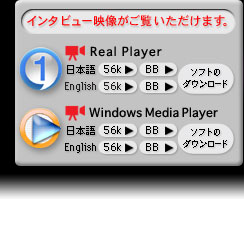
|
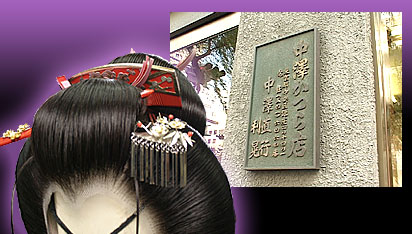 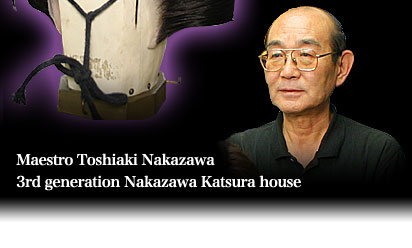 |
 |
Since the Edo era, there have been a number of popular theaters named "Yamamura-za" and "Morita-za". It used to be called the "Kobiki-cho theater district," the former name of the area. Kabuki-za, since its establishment in 1988, has helped raise Kabuki to the great level it has today in representing Japanese culture for the past 400 years. The "Katsura", or wig, is one of the essential elements used that has helped maintain the elaborate beauty of kabuki behind the scenes. Due to the number of theaters, a similar number of katsura houses also exist in Chuo-ku. This month's feature introduction interview is with Maestro Toshiaki Nakayama, the third generation "Nakazawa Katsura ten", located in front of the Kabuki-za theater. |
 |
 |
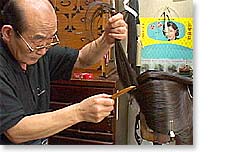 |
| Tokoyama |
 |
| Crafting katsura is divided into two main processes. "Katsura-shi" to make the body, make the base stable on a stand, and straighten the hair; "Tokoyama" to comb the hair and slightly curl the hair line with tongs to give it volume, then fix the whole shape. At our house, we used to do both until my father's generation. I was trained to be Tokoyama and my brother was trained to be Katsura-shi because of my father's will. Today my brother has a Katsura-house independent from me. |
|
 |
 |
| Until I inherited the 3rd generation: |
 |
I have been living in this place since my birth in 1938 (Showa 13). For 7 years since 1955, I did aesthetic training at the Kabuki-za theater. By observing the techniques of the masters and seniors, and watching the plays, I did my own practice during these years at Kabuki-za. I then returned to work for my father from 1962. However, since I was so fulfilled to be trained at Kabuki-za, I left home with great reluctance. Father passed away in 1988, so I became the 3rd generation owner accordingly. My grandfather, the founder, was making "Jikatsuras"
- those are for geisha and brides. My father then started making katsura for classical Japanese dances and plays which I make today.
|
| The technique: |
 |
It takes about an hour to an hour and a half to finish the whole shape for Katsura. There are numerous hairstyles, and all of them have their own difficulties. Tokoyama's responsibility is not limited to shaping the hairs but rather finishing it up after putting hair ornaments and to make customers wear it. "I was taught that well-trained craft workers should be able to let the audience distinguish the age or social rank of the play role without hair ornaments, just by looking at the hair, although it is always easier with hair ornaments on. Being tokoyama requires certain skills. But reaching the level to make the hair style distinguishable by audiences without hair ornaments requires a special knack for doing so. No one can teach us, we can only acquire this sense by ourselves, by watching plays, other people's works, do many of our own works, and start building up our own aesthetics. To this day, I am working to get close to that level.
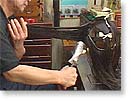  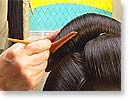
| 1.comb the hair |
|
2.tie the knot
|
|
3.finish up
|
|
|
|
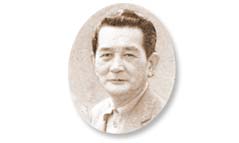
The founder
Maestro Naoyuki Nakazawa
|
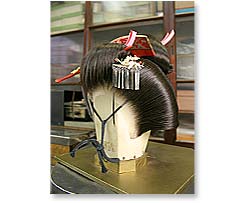
Formal hair for the young lady in Meiji period
'Takashimada' style
|
|
|
 |
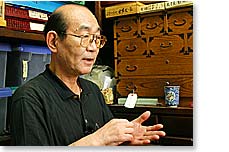 |
| Amidst total harmony: |
 |
What I care about the most is to satisfy my customers. Customers really like the katsura I make, and are not willing to take off their katsura even when their parts are finished because it's very comfortable. Instead, when I see customers taking off their katsura soon after the play, I feel so shameful, which makes me seek the reasons and make sure to not repeat the same mistakes.There are two ways to measure customer satisfaction - fitting and looking. For the looking part, no matter how beautifully it is finished by tokoyama, if it does not match with the whole costume and the makeup, it gives the audience odd impressions. So, we need to check the facial and physical shapes of customers, and total costume designs and colors in the first place. This means that total harmony is indispensable for customer satisfaction. We need to remember that crafting katsura is a part of making a whole stage in harmony. In this
context, I can say, crafting katsura can be the ultimate "made to order". |
| Under concentration: |
 |
| During the creation process, I get taciturn because of the extremely tense and focused nature of the work. Some say "Craftspeople are difficult and hard to approach," but it is because we are concentrating to do the best for our customers. We definitely need concentration in order to brush up and maintain our techniques. |
|
 |
 |
| Katsura and the future: |
 |
We used to wear kimono and katsura for New Year's celebrations, but there are no regular customers who do so in recent years. As katsura demands for classical japanese dance or commercial plays are still
there, I do not need to worry about our jobs ending, but I do need to worry that materials are harder to find. The prices are getting higher and supplies are increasingly uncertain from year to year, especially human hair, which depends on imports. An alternate material is artificial nylon hair, yet the japanese hair style is impossible with this since it melts in the heat. Though it is the best to make japanese hair style with japanese hair, it is a difficult situation.
|
|
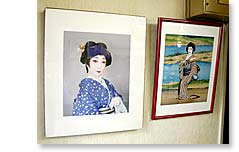 |
|
 |